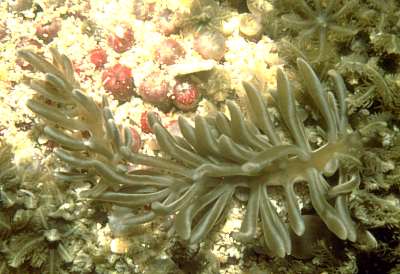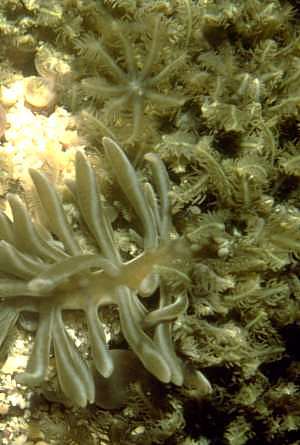

Phyllodesmium colemani
Rudman, 1991
Order: NUDIBRANCHIA
Suborder: AEOLIDINA
Family: Glaucidae
DISTRIBUTION
Western Pacific [Lord Howe Island, Philippines]
PHOTO
Upper Photo: 2 animals, large one on right is Holotype, 18mm long preserved, AM C161935. Smaller animal, 12mm long preserved, is a paratypes, AM C155175. Lower Photo: anterior end of holotype in colony of Tubipora musica, Lord Howe Island. Photo: Neville Coleman.
The body is narrow and elongate with up to eleven groups of cerata down each side of the body. Both the oral tentacles and the rhinophores are long smooth and tapering. The foot is narrow, no wider than the body, and at its anterior end it broadens to form a wide semicircular leading edge with angular corners. The precardiac cerata on each side are arranged in a single-rowed arch of about ten cerata, the uppermost being the longest. The postcardiac cerata are arranged in a series of up to ten vertical rows spaced evenly down the body and usually slightly raised on ridges. The number of cerata in each row progressively decreases posteriorly, the first postcardiac row having up to six cerata and the most posterior sometimes reduced to a single row. As in the precardiac cerata, the uppermost ceras in each row is the longest.
The colour pattern appears to be variable. In animals from the type locality [Lord Howe Island]the body and cerata are a translucent greenish brown with small brown specks clearly visible on the dorsal surface of the body and the cerata. There are greenish white patches down either side of the body below and between the cerata. The edges of the somewhat flattened cerata are lined with a band of greenish white which join at the tip of the ceras. In specimens illustrated in the Forum for the Philippines the background brown lacks a greenish tinge and on the cerata there are scatterd white patches. I assume the difference in brown reflects a differences in the colour of the zooxanthellae which are stored in the modified ducts of the digestive gland [see page on Solar powered slugs.
This species apparently feeds exclusively on the stoloniferan Organ pipe Coral, Tubipora musica.
Reference:
• Rudman, W.B. (1991). Further studies on the taxonomy and biology of the octocoral-feeding genus Phyllodesmium Ehrenberg, 1831 (Nudibranchia: Aeolidoidea). Journal of Molluscan Studies, 57: 167-203.
Rudman, W.B., 2003 (December 21) Phyllodesmium colemani Rudman, 1991. [In] Sea Slug Forum. Australian Museum, Sydney. Available from http://www.seaslugforum.net/factsheet/phylcole
Related messages
-
Phyllodesmium colemani from Indonesia
From: Aaron Fink, July 6, 2007 -
Another Phyllodesmium colemani from the Philippines
From: Erwin Koehler, December 22, 2003 -
Phyllodesmium colemani from Lord Howe Island
From: W.B. Rudman, December 22, 2003 -
Phyllodesmium colemani ? from the Philippines
From: Erwin Koehler, December 21, 2003
